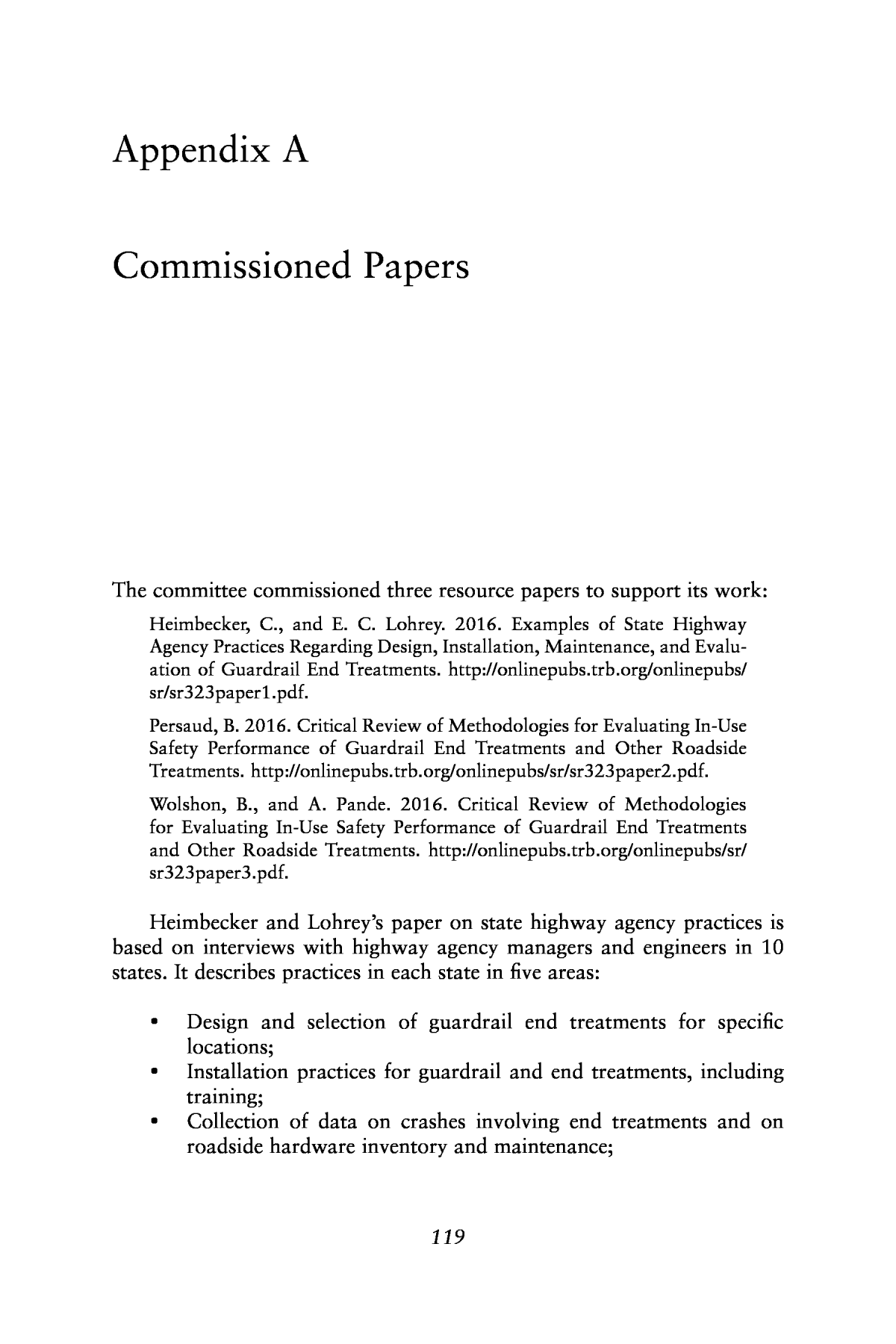


Below is the uncorrected machine-read text of this chapter, intended to provide our own search engines and external engines with highly rich, chapter-representative searchable text of each book. Because it is UNCORRECTED material, please consider the following text as a useful but insufficient proxy for the authoritative book pages.
Appendix A Commissioned Papers The committee commissioned three resource papers to support its work: Heimbecker, C., and E. C. Lohrey. 2016. Examples of State Highway Agency Practices Regarding Design, Installation, Maintenance, and Evalu- ation of Guardrail End Treatments. http://onlinepubs.trb.org/onlinepubs/ sr/sr323paper1.pdf. Persaud, B. 2016. Critical Review of Methodologies for Evaluating In-Use Safety Performance of Guardrail End Treatments and Other Roadside Treatments. http://onlinepubs.trb.org/onlinepubs/sr/sr323paper2.pdf. Wolshon, B., and A. Pande. 2016. Critical Review of Methodologies for Evaluating In-Use Safety Performance of Guardrail End Treatments and Other Roadside Treatments. http://onlinepubs.trb.org/onlinepubs/sr/ sr323paper3.pdf. Heimbecker and Lohreyâs paper on state highway agency practices is based on interviews with highway agency managers and engineers in 10 states. It describes practices in each state in five areas: ⢠Design and selection of guardrail end treatments for specific locations; ⢠Installation practices for guardrail and end treatments, including training; ⢠Collection of data on crashes involving end treatments and on roadside hardware inventory and maintenance; 119
120 PERFORMANCE EVALUATION OF GUARDRAIL END TREATMENTS ⢠Maintenance practices for guardrail and end treatments; and ⢠In-service evaluation of performance of roadside hardware. Highlights of the authorsâ conclusions related to the committeeâs task in- clude the following: ⢠In construction projects, highway agency designers typically specify the category of end treatment (e.g., energy absorbing or nonâ energy absorbing) to be installed at each location. The contractor chooses the manufacturer and model from a list of approved prod- ucts provided by the agency. ⢠Nearly all new end treatments are installed by guardrail specialty contractors, who are monitored by state personnel or consultant inspectors. Four of the 10 agencies interviewed require training and certification for installers of end treatments. ⢠Three of the 10 states maintain a regularly updated systemwide inventory of end treatments. ⢠On-site maintenance inspection of end treatments is conducted on a regular schedule by five of the 10 states interviewed. The remain- ing states inspect end treatments by drive-by observation during routine patrols. ⢠None of the agencies interviewed was currently conducting a formal in-service evaluation of guardrail end treatments, other than three agencies participating in the Federal Highway Administrationâs 2016 in-service evaluation pilot study (described in Chapter 3). Three agencies reported having conducted such an evaluation in the past. Nearly all expressed an interest in obtaining information on end treatment in-service performance and in conducting evalu- ations themselves, if the processes were straightforward and not extraordinarily labor intensive. The authors of each of the two papers presenting critical reviews of methodologies for evaluating end treatments (Persaud 2016; Wolshon and Pande 2016) were assigned identical tasks by the committee. The authors were asked to conduct selective, critical, and comparative reviews of in-use evaluations of the safety of roadside devices and design features and also to review evaluation methods used in fields other than road safety. The reviews identify methods suitable for specific applications, including ⢠Comparing the effectiveness of alternative end treatment designs, ⢠Assessing the effect of installation and maintenance practices on performance,
APPENDIX A 121 ⢠Estimating benefits and costs of replacing installed end treatments with better-performing designs, ⢠Providing data to support the improvement of end treatment de- signs, and ⢠Refining crash test procedures. The reviews summarize examples of study design and data analysis methods for these applications, including the case-control method and multivariate methods of risk modeling, including the empirical Bayes method.
